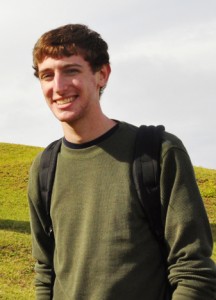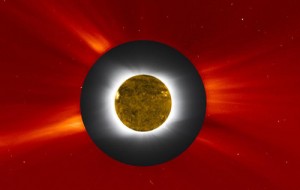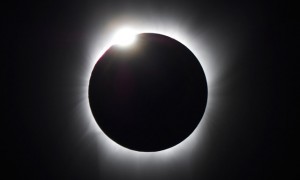Malamut’s Astronomy Research has been Out of this World

In the summer of 2010 Craig Malamut traveled to the Easter Islands to study and photograph a rare solar eclipse. Soon after his eclipse observations were completed, NASA used one of his photographs in their official materials on the event. He also spent a week collaborating with astronomers from the University of Chile in Santiago to study Pluto’s atmosphere as it obscured the light from a faint star. This year, Malamut has coauthored two papers for astronomical journals and is analyzing data from the Hubble Space Telescope on gas and dust clouds lying near the sun and other nearby stars.
It’s the kind two-year research run that many scientists would be proud and excited to have accomplished. But Craig Malamut is not a paid researcher or a member of any faculty. He’s a college student who is still working through his senior year at Wesleyan.
Malamut, an astronomy major, has been working at an advanced level for someone who has yet to earn a bachelor’s degree. While the experience has been intense, he hasn’t been intimidated by the complexity of the work or felt limited by his undergraduate standing. “I’ve felt very prepared for this level of research from the courses, discussions, and advising I received from the astronomy department,” he says. “Professors Herbst, Moran, Redfield, and Kilgard do a great job getting their students involved early in astronomy research, whether at Wesleyan or abroad.”
He also took part in the Keck Northeast Astronomy Consortium Research Experience for Undergraduates (KNAC REU) Williams College. Several members of astronomy faculty also recommended him for the Keck-sponsored program in the Easter Islands.

Malamut became involved in active research at Wesleyan after talking to Seth Redfield, assistant professor of astronomy. Redfield, whose areas of specialty include investigating nearby clouds of gas and dust in space, known also as Local Interstellar Medium (LISM), welcomed Malamut. Soon the student was examining previously unquantified LISM data.
“Craig is a very sharp student and he has the right mixture of astrophysical knowledge, creativity, and practical skills to conduct research,” says Redfield. “His current research project involves analyzing data taken by the Hubble Space Telescope of the gas in the immediate vicinity of the Sun. These are new and exciting observations, and he is the first person to analyze them.”
Malamut was chosen to join a small select group that traveled half way across the globe to observe and photograph a total solar eclipse in July, 2010.
“It was one of the least viewed total solar eclipses in recent history due to the fact that most of the path of totality went over the Pacific Ocean,” Malamut says. The group’s primary interest was the structure and behavior of the Sun’s corona during the eclipse. The unusually long total solar eclipse (the sun fully eclipsed the moon for nearly five minutes) provided a valuable data collection window. Malamut was part of a team, led by Williams Professor Jay Pasachoff. that marshaled seven different cameras to make hundreds of high-resolution images. The best of these images were integrated into a single, definitive image of the solar corona. Their results were compared with another team’s results that did identical overlays of images taken of the total eclipse from the island of Tatakoto, as well as NASA’s images.
According to Malamut, the combined effort allowed researchers to see how “the inner most regions of the corona changed over a very short timescale.”

His research also resulted in co-authorship in two papers that were published this year: “Structure and Dynamics of the 2010 July 11 Eclipse White-Light Corona,” which appeared in the June 20, 2011 issue of The Astrophysical Journal, and “High-Resolution Imaging of the 2010 Total Solar Eclipse at Easter Island,” which appeared in the The Coronal Courant, which is maintained by the Solar Physics Division of the American
Astronomical Society (AAS).
“Craig is a wonderful student to have as part of our program,” says Bill Herbst, Van Vleck Professor of Astronomy. “He is interested in many different subjects and has taken advantage of the opportunities that Wesleyan provides.
Malamut is scheduled to graduate in 2012, but he is strongly considering Wesleyan’s B.A./M.A. program in Astronomy. He also talks about working in science outreach.
“I think there’s a big need for wider science literacy and support of science in the public sphere,” he says. “This is especially true in today’s rapidly-changing world.”

